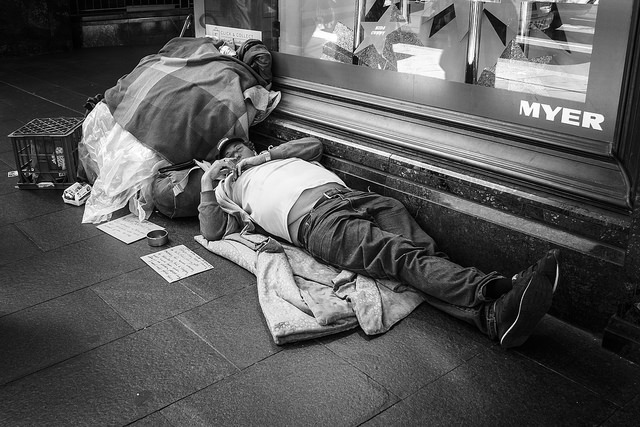Homelessness Australia is driving national discussions about housing and homelessness this week as part of the country’s annual Homelessness Prevention Week.
There are about 105, 237 people in Australia who are homeless. With each day Homelessness Australia say these numbers lamentably continue to rise.

Homelessness statistics from the ABS Housing and Population and the AIHW Specialist Homeless Services data
Homelessness Prevention week is about putting a face to these statistics, helping to dispel, relinquish and correct the stereotypes often associated with homelessness. Throughout the week more than 200 events will be held across the nation.
Policy and research officer at Homelessness Australia, William Mudford, says this week is about coordinating a national voice for homelessness services to the federal government, state and territory governments, other services across Australia and the wider population.
Homelessness in Victoria
In Victoria, roughly 23,000 people are homeless. The Council to Homeless Persons (CHP) is the peak body for organisations and individuals interested in reducing this figure.

State homelessness statistics from the ABS Housing and Population and the AIHW Specialist Homeless Services data
The council is holding lunchtime seminars this week at the Melbourne Town Hall, allowing people who have experienced homelessness first hand or dealt with people who are homeless to talk about solutions worth investing in.
Policy and communications manager at the Council to Homeless Persons, Sarah Toohey, says solutions to homelessness are simple.
“It’s all about about getting a roof over people’s heads and getting them the help they need to keep it,” she said.
Homelessness is not a linear social problem. There are many catalysts that can force a person out of his or her home and onto the streets.
For people who have been sleeping rough for an extended period of time, the main aim of organisations like CHP is to find permanent accommodation. Organisations can also help them get in touch with long-term mental health, drug and alcohol support services.
For people fleeing their homes because of family violence, Ms Toohey said often what they need is a bit of financial help to get them back on their feet and back into long-term housing. Access to counselling services is also of a high priority.
“The solution is dependent on the cause. But the solution is always dependent on people having affordable housing and a place to stay,” she said.
This is where services such as HomeGround Real Estate come in.
According to HomeGround Services CEO Heather Holst, it is the housing affordability crisis in Victoria that is tossing more and more people onto the streets.
HomeGround aims to make housing more affordable and accessible to people of low-income households.
The service offers three options:
1. Landlords engage with HomeGround to manage their property on a commercial basis
2. Landlords allow their property to be rented out at a below market rent rate
3. Landlords offer their property to HomeGround at any rent
“It is a really great initiative,” Ms Toohey said. “Even if people don’t want to have a discount on rent, just by using HomeGround Real Estate they are contributing to combatting Australia’s homelessness and housing affordability crises.”
Homelessness and the federal government
According to Mr Mudford, the current federal government has removed, downsized and negatively impacted the entities and bodies that were passed with needing to coordinate ending homelessness in the 2008 White Paper, ‘The Road Home’.
“[These entities] include the national housing supply council and the prime minister’s advisory body on homelessness,” Mr Mudford said.
Ms Toohey agrees that homelessness is a “national problem that needs national attention”.
“We’d like to see the general public expressing to their members for parliament and their local councillors the need for more social housing in their community and the need for government to invest in building social housing … that’s absolutely critical,” she said.
Image credit: @Flickr Image by Vincent Albanese







[…] This story can be found on RMIT’s City Journal website. To view the article in full click here. […]